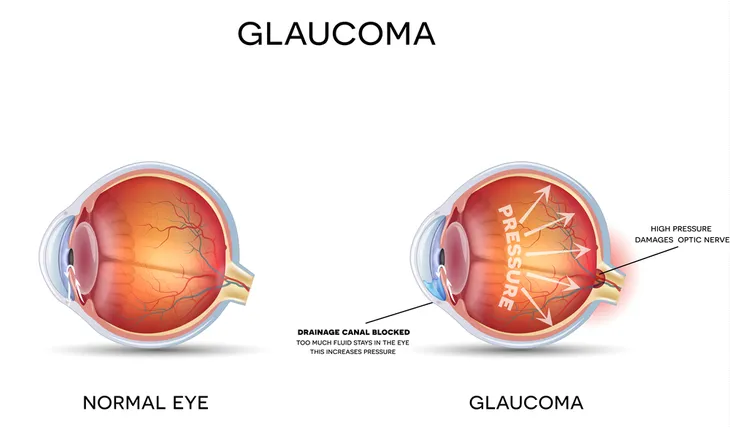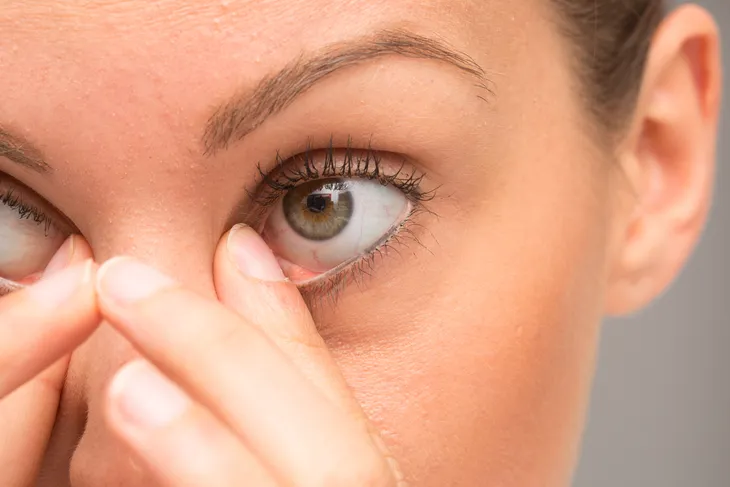Glaucoma is a degenerative eye disease (of which there are several different forms) that can completely rob you of your vision. It affects around 3-million Americans and is a leading cause of blindness. However, the good news is, it can be treated.
While it affects many people, apparently most people who have glaucoma aren’t aware of it, according to the Glaucoma Research Foundation. How do you know? Let’s take a look at the 12 telltale signs that should prompt you to see a physician or optometrist…
Risk Factors
One major form of glaucoma called “open-angle” (which is actually the most common type) typically doesn’t have any warning signs, explains the Glaucoma Research Foundation. The initial loss of sight in this form of the disease occurs in the peripheral vision, or the “fringes” of what you can see from the sides, so you may not notice.
However, you should regularly see your eye doctor for checkups, especially if you fall into a higher risk category—if your parents had the disease, if you are African American or Latino, or if you have diabetes or a cardiovascular disease, adds the source. Learn more about the risk factors in the article “Risk Factors for Glaucoma.”
Ocular Hypertension
Glaucoma causes your eye pressure to increase due to fluid buildup, coupled with your eye’s inability to regulate the internal pressure. This causes parts of your eye to expand, pushing against the delicate optic nerve and leading to vision problems (or loss).
It’s possible to have no obvious signs of glaucoma while also showing higher pressure readings, making you a “glaucoma suspect,” notes the American Academy of Ophthalmology. Your doctor or eye care professional will be able to determine eye pressure quickly with that little blast of air during a routine eye exam.
Eye and Head Pain
If you’re noticing some sudden sharp pangs of pain in your eyes, or you have a bad headache that seems to have come out of nowhere, you should keep a close eye on it (so to speak). These may be symptoms of acute angle-closure glaucoma, another common form of the disease.
AllAboutVision.com notes these sudden symptoms (which can also include nausea and vomiting) can warrant a trip to the emergency room, and the “attacks” can last a few hours. Each time you have one of these pain episodes, it can further erode your vision, adds the source.
Halos around Lights
The same source notes that acute angle-closure glaucoma can yield more obvious signs, namely those that directly affect your ability to see clearly. You may start to notice halos around lights (or overall haziness), as you may have when your eyeglasses are smudged.
You may also have some noticeable vision loss—don’t ignore these signs and wish they’d go away. They need to be handled by an eye care professional to slow the progression. As mentioned earlier, vision loss may be a sign that you’re already in an advanced stage of another form of the disease.
Hazy Eyes
While glaucoma can cause your vision to be hazy, you may also be able to tell whether someone is developing glaucoma by a telltale hazy appearance of their eyes, according to WebMD.
This particular symptom is apparently more common in infants (and yes, that means infants can get glaucoma too, although it’s quite rare), adds the source. A cloudy cornea is a major warning sign of childhood glaucoma. While we’re on the subject of childhood glaucoma, also be on the lookout for overly teary eyes (when the child isn’t crying) and light sensitivity.
Redness of the Eyes
Your eyes can become red and inflamed for a number of reasons, but one of these reasons could be related to glaucoma. Redness can be the result of a rise in pressure of the eye and not from other obvious causes such as rubbing your eyes or having irritants come into contact with your eye.
The Glaucoma Foundation notes that red eyes from glaucoma will often be accompanied by some of the symptoms we described earlier—namely pain, nausea, and vomiting. Along with redness, your eyes may actually swell, adds the source. Get yourself emergency care quickly if you have these symptoms and be sure to see your eye doctor every 2-years (or every year if you’re 61-years-old and older).
Nausea
Along with what can be “severe” eye pain, you may find yourself feeling nauseous and vomiting as a result of the onset of glaucoma, according to the BrightFocus Foundation.
This symptom is usually associated with acute angle-closure glaucoma, which is considered a medical emergency that should be attended to by a medical professional immediately or blindness can result in as little as 24-hours, warns the source.
Tunnel Vision
One of the major causes of loss of peripheral vision (the ability to see “out of the corner of your eye”) is glaucoma, notes AllAboutVision.com. This is due to the damage to the optic nerve caused by the eye disease.
You may notice that objects directly in front of you look fine, but you don’t notice movement or objects to your side like you normally would. “Moderate and severe cases of peripheral vision loss create the sensation of seeing through a narrow tube, a condition commonly referred to as tunnel vision,” adds the source.
Blind Spots
The Mayo Clinic says more than your peripheral vision can be affected by glaucoma. In the case of the more common open-angle glaucoma, you may experience “patchy blind spots” in your side and central vision.
These blind spots can often affect both eyes simultaneously. Tunnel vision is usually what occurs in more advanced stages, so it’s best to see an eye doctor when you experience any vision loss.
Dilated Pupils
The Glaucoma Foundation explains this symptom is related to acute glaucoma, the more sudden and serious version of the problem where eye pressure increases rapidly rather than gradually over time.
The source explains that many acute glaucoma attacks occur in darkened rooms, such as a movie theater, causing the pupil to increase in size (dilate). “When this happens, there is maximum contact between the eye’s lens and the iris. This further narrows the angle and may trigger an attack,” notes the source. Acute glaucoma attacks can also occur when you’re anxious or stressed, which also dilates the pupils.
Sudden Vision Loss
Typically, most cases of open-angle glaucoma will reduce your vision slowly over time before you even notice. In fact, glaucoma has even been nicknamed the “silent thief of sight.” However, in acute cases, you can lose vision a lot quicker.
The Glaucoma Research Foundation explains you can lose some of sight in a short amount of time due to a sudden rise in eye pressure that affects the optic nerve. As we’ve mentioned, don’t hesitate to get to a medical professional as soon as possible to try and limit the damage.
Sensitivity to Light
Healthline.com says that even young people aren’t safe from glaucoma, and some are born with a congenital form that “slows or prevents normal fluid drainage” due to a defect in the angle of their eye.
When children have this form of glaucoma, it will usually present with symptoms including cloudy eyes and excessive tearing as we mentioned earlier, as well as increased sensitivity to light (medically known as photophobia). If you notice your child squinting a lot or crying in bright conditions, they should see an eye doctor. Light sensitivity can be a symptom of glaucoma in adults too.















